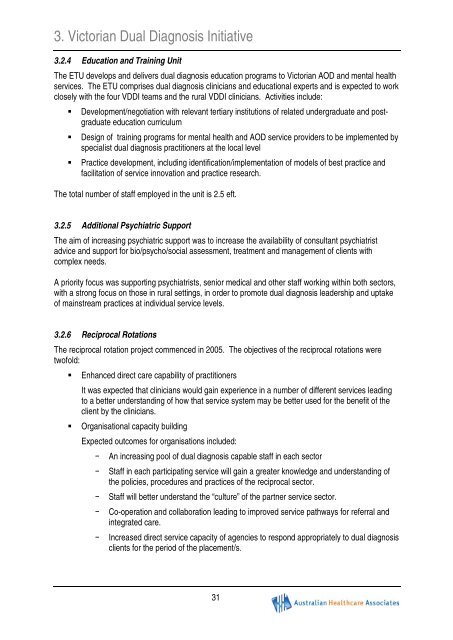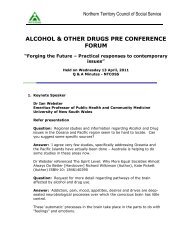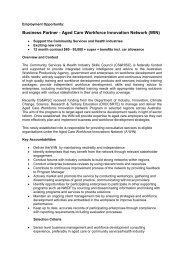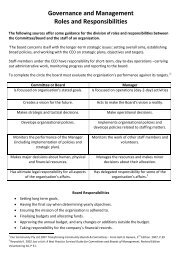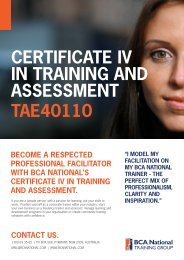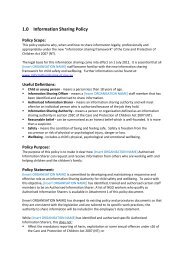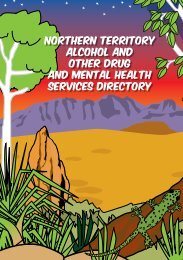(2011) Evaluation of the Victorian Dual Diagnosis Initiative
(2011) Evaluation of the Victorian Dual Diagnosis Initiative
(2011) Evaluation of the Victorian Dual Diagnosis Initiative
You also want an ePaper? Increase the reach of your titles
YUMPU automatically turns print PDFs into web optimized ePapers that Google loves.
3. <strong>Victorian</strong> <strong>Dual</strong> <strong>Diagnosis</strong> <strong>Initiative</strong><br />
3.2.4 Education and Training Unit<br />
The ETU develops and delivers dual diagnosis education programs to <strong>Victorian</strong> AOD and mental health<br />
services. The ETU comprises dual diagnosis clinicians and educational experts and is expected to work<br />
closely with <strong>the</strong> four VDDI teams and <strong>the</strong> rural VDDI clinicians. Activities include:<br />
• Development/negotiation with relevant tertiary institutions <strong>of</strong> related undergraduate and postgraduate<br />
education curriculum<br />
• Design <strong>of</strong> training programs for mental health and AOD service providers to be implemented by<br />
specialist dual diagnosis practitioners at <strong>the</strong> local level<br />
• Practice development, including identification/implementation <strong>of</strong> models <strong>of</strong> best practice and<br />
facilitation <strong>of</strong> service innovation and practice research.<br />
The total number <strong>of</strong> staff employed in <strong>the</strong> unit is 2.5 eft.<br />
3.2.5 Additional Psychiatric Support<br />
The aim <strong>of</strong> increasing psychiatric support was to increase <strong>the</strong> availability <strong>of</strong> consultant psychiatrist<br />
advice and support for bio/psycho/social assessment, treatment and management <strong>of</strong> clients with<br />
complex needs.<br />
A priority focus was supporting psychiatrists, senior medical and o<strong>the</strong>r staff working within both sectors,<br />
with a strong focus on those in rural settings, in order to promote dual diagnosis leadership and uptake<br />
<strong>of</strong> mainstream practices at individual service levels.<br />
3.2.6 Reciprocal Rotations<br />
The reciprocal rotation project commenced in 2005. The objectives <strong>of</strong> <strong>the</strong> reciprocal rotations were<br />
tw<strong>of</strong>old:<br />
• Enhanced direct care capability <strong>of</strong> practitioners<br />
It was expected that clinicians would gain experience in a number <strong>of</strong> different services leading<br />
to a better understanding <strong>of</strong> how that service system may be better used for <strong>the</strong> benefit <strong>of</strong> <strong>the</strong><br />
client by <strong>the</strong> clinicians.<br />
• Organisational capacity building<br />
Expected outcomes for organisations included:<br />
− An increasing pool <strong>of</strong> dual diagnosis capable staff in each sector<br />
− Staff in each participating service will gain a greater knowledge and understanding <strong>of</strong><br />
<strong>the</strong> policies, procedures and practices <strong>of</strong> <strong>the</strong> reciprocal sector.<br />
− Staff will better understand <strong>the</strong> “culture” <strong>of</strong> <strong>the</strong> partner service sector.<br />
− Co-operation and collaboration leading to improved service pathways for referral and<br />
integrated care.<br />
− Increased direct service capacity <strong>of</strong> agencies to respond appropriately to dual diagnosis<br />
clients for <strong>the</strong> period <strong>of</strong> <strong>the</strong> placement/s.<br />
31


